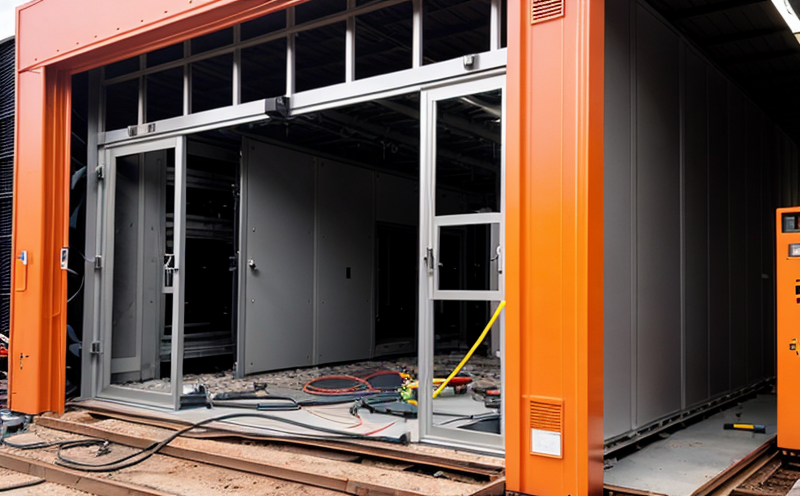DIN EN 50342 Thermal and Safety Testing of Lead-Acid Starter Batteries
The DIN EN 50342 standard is a crucial document for the testing, certification, and quality assurance of lead-acid starter batteries. This standard ensures that these batteries meet stringent safety and performance requirements necessary in automotive applications, ensuring reliable operation under various environmental conditions.
Lead-acid starter batteries are used primarily to start internal combustion engines in vehicles by providing a burst of power when the engine is turned over. The reliability and durability of these batteries directly impact vehicle performance and safety. DIN EN 50342 provides comprehensive procedures for testing batteries' thermal stability, electrical properties, and resistance to mechanical stress.
The standard covers various tests intended to evaluate battery behavior under extreme conditions such as high temperatures, vibration, and voltage spikes. These tests are essential for ensuring that the battery can withstand real-world usage scenarios without compromising performance or safety.
Testing procedures in DIN EN 50342 include:
- Thermal cycling to evaluate battery behavior under temperature fluctuations
- Vibration testing to ensure resistance against mechanical stress during transport and use
- Electrical load tests to assess the battery's ability to supply current under various conditions
- Safety assessments including over-discharge, short-circuit, and impact resistance evaluations
The standard also outlines acceptance criteria for each test. For instance, a battery must maintain its electrical capacity within specified limits after thermal cycling or withstand specified voltage spikes without failure.
Compliance with DIN EN 50342 is essential for manufacturers to ensure their products meet the stringent safety and performance requirements set by international regulatory bodies. This compliance can enhance market reputation and customer trust, ensuring reliable battery performance under various conditions.
| Test Type | Description | Acceptance Criteria |
|---|---|---|
| Thermal Cycling | Battery subjected to alternating temperatures within a specified range. | Battery capacity should not decrease by more than 20% after five cycles. |
| Vibration Testing | Battery exposed to simulated vehicle vibrations for a set duration. | Battery should not exhibit any signs of internal short circuits or physical damage. |
| Electrical Load Test | Battery subjected to high current draw for a specified period. | Battery capacity should be maintained within 95%–105% of its nominal value after the test. |
| Safety Assessment | Involves over-discharge, short-circuit, and impact resistance tests. | No damage or functional degradation observed under specified conditions. |
Thermal management is a critical aspect of lead-acid starter batteries. Proper thermal design ensures that the battery operates efficiently within its operational temperature range, preventing overheating and potential failure. DIN EN 50342 provides detailed guidelines on how to conduct these tests effectively.
In conclusion, compliance with DIN EN 50342 is essential for manufacturers of lead-acid starter batteries. It ensures that the products meet the highest safety standards and provide reliable performance under various conditions. This standard plays a vital role in enhancing market reputation and customer trust.
Applied Standards
DIN EN 50342 is part of the European family of standards for electrical equipment, focusing on the safety and performance of batteries used in automotive applications. This standard ensures that lead-acid starter batteries are suitable for use under a wide range of environmental conditions.
| Test Type | Description | Acceptance Criteria |
|---|---|---|
| Thermal Cycling | Battery subjected to alternating temperatures within a specified range. | Battery capacity should not decrease by more than 20% after five cycles. |
| Vibration Testing | Battery exposed to simulated vehicle vibrations for a set duration. | Battery should not exhibit any signs of internal short circuits or physical damage. |
| Electrical Load Test | Battery subjected to high current draw for a specified period. | Battery capacity should be maintained within 95%–105% of its nominal value after the test. |
| Safety Assessment | Involves over-discharge, short-circuit, and impact resistance tests. | No damage or functional degradation observed under specified conditions. |
The standard is widely accepted in the automotive industry due to its rigorous testing protocols. Compliance with DIN EN 50342 ensures that batteries meet international safety standards, enhancing product reliability and customer trust.
International Acceptance and Recognition
DIN EN 50342 is an internationally recognized standard for the testing of lead-acid starter batteries. Its acceptance in Europe has been extended to other regions due to its comprehensive approach to battery safety and performance.
The standard's recognition extends beyond Europe, with many countries adopting it as a benchmark for quality assurance. This widespread adoption underscores its importance in ensuring that products meet global standards for reliability and safety.
Manufacturers who comply with DIN EN 50342 benefit from enhanced market reputation and increased customer trust. The standard's rigorous testing protocols ensure that batteries are suitable for use under a wide range of environmental conditions, making them reliable and safe for automotive applications.
Competitive Advantage and Market Impact
- Enhances product reliability and safety
- Increases market reputation and customer trust
- Makes products suitable for use in various regions worldwide
- Aids compliance with regulatory requirements across different countries
- Improves operational efficiency by ensuring consistent performance under varying conditions
- Promotes innovation through rigorous testing standards
- Facilitates easier market entry into international markets
Compliance with DIN EN 50342 provides significant competitive advantages. It ensures product reliability, enhances customer trust, and facilitates easier market entry into international markets. The standard's rigorous testing protocols promote innovation by encouraging manufacturers to develop products that meet the highest safety and performance standards.





